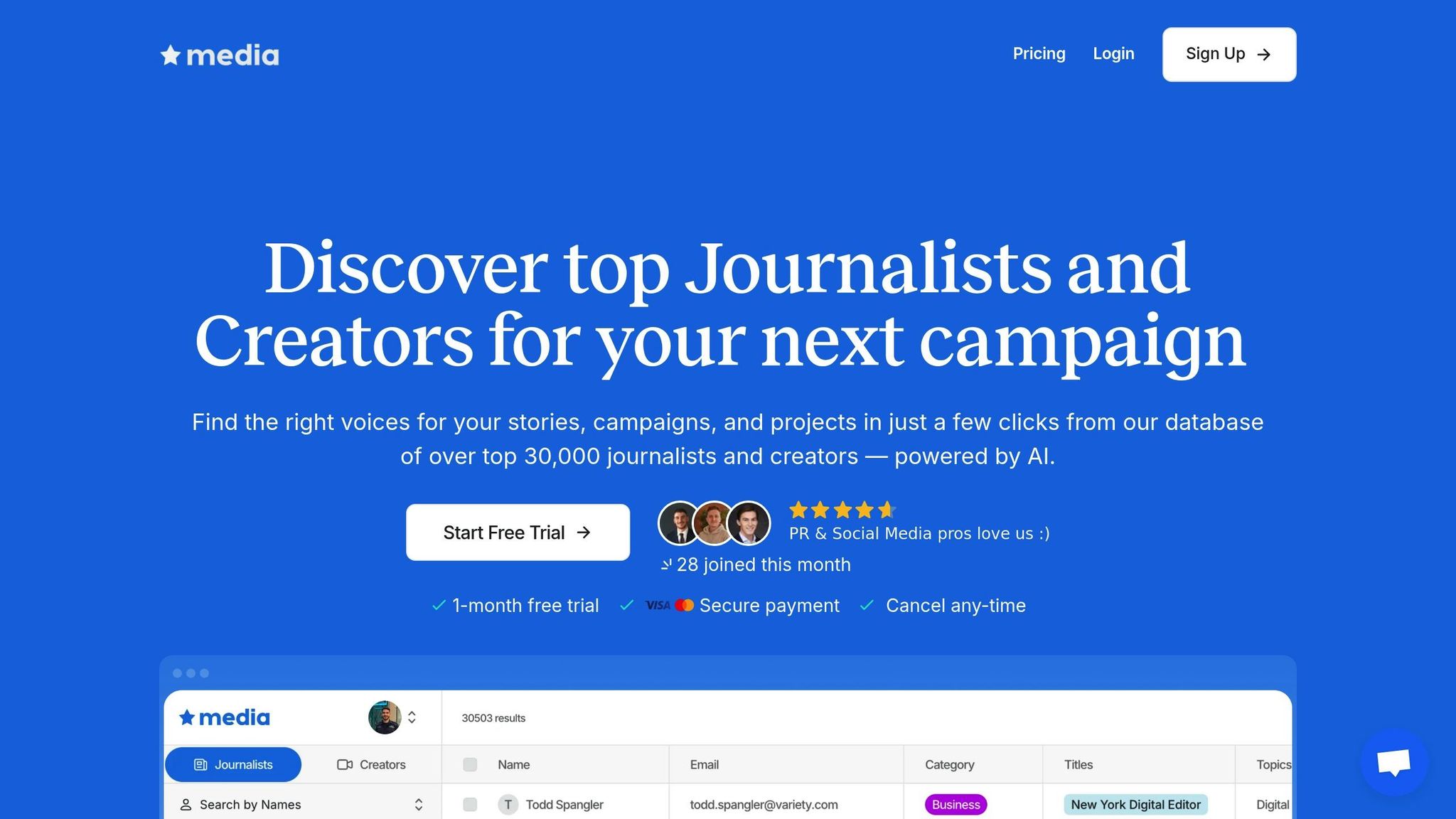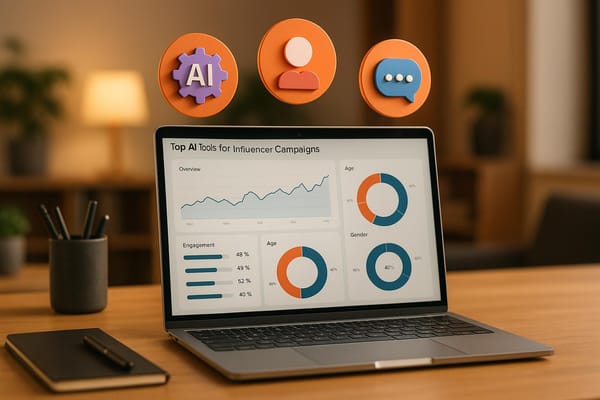How to Find Journalists for PR Outreach in 2025
Explore how AI transforms PR outreach by enhancing journalist targeting, personalizing pitches, and tracking real-time trends for effective communication.

Finding journalists in 2025 requires precision and smart use of technology. Here's the key takeaway: AI tools are now essential for identifying journalists who align with your story and audience. With journalists receiving over 50 pitches weekly and rejecting 86% of irrelevant ones, using AI for targeted outreach is no longer optional.
Quick Steps for Success:
- Define Goals & Audience: Be clear about your PR objectives and target audience. AI can analyze trends and preferences to refine your focus.
- Leverage AI for Research: Use AI to scan journalist profiles, recent articles, and social media activity to identify the best contacts.
- Personalize Pitches: Tailor your outreach based on journalist preferences and coverage areas. Reference their recent work to stand out.
- Track Trends in Real-Time: AI can help you spot emerging topics and time your pitches for maximum impact.
- Keep Data Updated: Use tools like Media AI to maintain accurate contact lists and monitor journalist role changes.
By combining AI insights with a human touch, PR professionals can build stronger relationships and improve response rates. AI doesn't replace relationships - it enhances them.
PR Pros, Meet Your New Assistant: Creating a Media List with AI Agents
How AI Changes PR Outreach
AI is reshaping PR outreach, turning it into more of a precision science than a guessing game. Instead of sending out blanket pitches to hundreds of journalists and hoping for a response, AI dives into massive datasets to uncover insights that humans simply can't process. This allows for hyper-targeted campaigns that match the right story with the right journalist at just the right time. Let’s break down how AI builds detailed journalist profiles and tracks media trends to supercharge outreach.
This shift is about more than just automation. AI scans digital publications, social media, and search trends to uncover patterns and opportunities that human researchers might overlook. By combining an understanding of journalist preferences with a grasp of shifting trends, PR teams can achieve much more precise and effective outreach.
"AI enhances efficiency, but it doesn't replace relationships. The best PR professionals will blend AI-driven insights with strong storytelling, strategic thinking, and authentic human connections."
What sets AI apart is its ability to process and interpret information at lightning speed. While traditional PR research might take hours to figure out a journalist's recent interests, AI not only does this in moments but also identifies emerging trends and predicts the best timing for outreach. Companies using AI have reported quicker journalist engagement and more timely pitches.
AI-Powered Journalist Profiles
One of AI's standout features is its ability to create in-depth journalist profiles. By analyzing past articles, tone, and areas of focus, it recommends pitches tailored to each journalist's preferences. These profiles go far beyond basic contact details, revealing writing styles, favored story angles, and even the types of sources a journalist frequently uses.
AI keeps tabs on journalists' latest work to pinpoint their current interests. For instance, if a tech journalist has been focusing on cybersecurity, AI will highlight this trend and suggest relevant pitches. This ensures that your outreach is aligned with what journalists are actively covering, boosting the likelihood of a response.
Timing is another area where AI shines. By analyzing when journalists typically publish, how often they cover specific topics, and their responsiveness to various pitches, AI helps PR teams time their outreach for maximum effect.
However, the human touch remains a critical piece of the puzzle. PR expert Gini Dietrich emphasizes this balance:
"We should use AI to generate insights, not do the heavy lifting... This means validating data, personalizing our approach, and respecting journalists' boundaries in an age of information overload."
With these profiles in hand, PR teams can fine-tune their strategies further using real-time trend analysis.
Real-Time Trend Analysis
AI also excels at identifying and reacting to emerging media trends in real time. Instead of waiting for trends to become obvious, AI picks up on early signals across platforms, giving PR teams a head start. It monitors online conversations, tracks consumer sentiment, and detects patterns across multiple channels. When a topic starts gaining traction, AI alerts PR teams, allowing them to craft pitches before the trend becomes oversaturated.
This real-time insight enables PR teams to pivot quickly in response to breaking news, current events, or shifts in public sentiment. For example, if a story relevant to your industry breaks, AI can pinpoint which journalists are covering it and suggest ways to position your brand within the narrative. Predictive analytics take this even further, helping PR teams anticipate trends and prepare pitches in advance. By analyzing historical data, AI can forecast when a topic is likely to peak, allowing PR professionals to act before the competition.
The results speak for themselves. Websites with consistent PR coverage in top-tier media outlets rank 43% higher for competitive keywords compared to those without media presence. By combining timing and relevance, AI gives PR teams a clear edge in today’s crowded media environment. With tools like real-time sentiment analysis and automated media monitoring, PR professionals can shift from simply reacting to trends to actively predicting and shaping them.
Step-by-Step Guide to Finding Journalists with AI
AI has revolutionized how PR professionals connect with journalists, offering tools that create detailed profiles, track trends, and streamline outreach. With 64% of PR professionals now incorporating generative AI into their workflow - up from just 23% a year ago - it's clear this approach delivers tangible results. By combining AI's data-crunching power with strategic decision-making, you can effectively identify journalists genuinely interested in your story. Here's how to make it happen.
Define Your PR Goals and Target Audience
Before diving into AI tools, set clear and specific goals. AI thrives on well-defined parameters, so vague objectives like "get more coverage" won't cut it. Instead, identify exactly what you want to achieve. Are you launching a product, addressing industry trends, or positioning a key executive as a thought leader? Each objective requires targeting different journalists and outlets.
Once your goal is set, focus on your target audience. AI can analyze vast datasets - like online interactions, customer feedback, and social media trends - to uncover what topics resonate most with your audience. For example, if you're aiming to reach tech decision-makers, AI can identify the publications they follow, the topics they engage with, and even the times they're most active online.
AI also excels in tracking behavioral patterns and content preferences, refining its recommendations as more data becomes available. This ensures your outreach aligns with journalists whose audience matches your ideal customer profile. With these insights, you can fine-tune your search parameters and move on to the next step.
Use Advanced Search and Filtering Features
With your objectives and audience defined, it's time to leverage AI's powerful search capabilities. Modern AI tools go beyond basic keyword searches by using machine learning to identify the most relevant journalists for your campaign. These tools analyze journalist profiles, article titles, social media activity, and bylined pieces to uncover connections you might otherwise miss.
Start with keywords that align with your campaign themes, then expand your search terms as needed. Use location filters to target specific regions and date ranges to find journalists covering relevant topics recently. Recent coverage often signals current interest, increasing the chances of engagement.
AI tools can also predict which journalists are most likely to respond to your outreach. By analyzing factors like past response rates, current coverage focus, and engagement levels, these platforms rank potential contacts by their likelihood of interest. Additionally, uploading your existing press lists into an AI-powered database can help you identify similar journalists or update outdated contact information, ensuring your outreach stays relevant and effective.
Organize and Export Journalist Contact Lists
Once you've identified the right journalists, the next step is turning your research into actionable campaigns. AI tools like Media AI make this process seamless with features that organize and export contact lists directly into your workflow.
Start by categorizing journalists based on their coverage areas, publication types, and engagement likelihood. AI can automatically tag contacts using data from recent articles, social media activity, and response patterns. This organization is especially useful when managing multiple campaigns or segmenting outreach efforts.
Media AI, for instance, offers a database of over 30,000 journalists and creators, complete with regularly updated contact details. Advanced filtering options let you refine lists by factors like publication tier, geographic focus, or coverage frequency, so your final contact list aligns perfectly with your campaign needs.
Exporting these lists should be straightforward and compatible with your existing PR tools or CRM systems. Look for platforms that offer customizable export formats, allowing you to include only the data fields your team needs. This eliminates manual data entry and ensures your outreach team has everything at their fingertips.
AI also keeps your contact database current by flagging changes in journalist roles, publications, or contact preferences. As journalists switch beats or move to new outlets, these tools suggest updates to maintain accuracy and improve the success of future campaigns.
How Media AI Makes Journalist Discovery Easier

Media AI has transformed the way PR professionals research and connect with journalists. Its extensive database of over 30,000 journalists and creators eliminates the tedious hours spent on manual research. Instead, it delivers detailed profiles and contact information in just seconds, making it an invaluable tool for building targeted media lists.
What sets Media AI apart is its ability to process vast amounts of data to pinpoint journalist interests. It ensures your pitches align with what journalists are actively covering, addressing one of the biggest reasons 86% of pitches are rejected - irrelevance to the journalist’s beat or audience. By focusing on up-to-date coverage areas rather than outdated directory information, Media AI ensures your outreach efforts are timely and on point.
Advanced Search and Filtering Options
Media AI's search tools take precision to a new level. Using machine learning, the platform analyzes journalist profiles, article histories, and coverage trends to deliver results tailored to your campaign goals. This goes far beyond simple keyword searches.
Geographic targeting is a standout feature, especially for campaigns tied to specific locations. Whether you're promoting a product launch in the Pacific Northwest or addressing policy changes in California, you can zero in on journalists covering those regions. The platform also keeps track of journalist movements, such as changes in beats or publications, ensuring your searches reflect the latest updates.
The results speak for themselves. Teams using AI-driven tools like Media AI report significant improvements in outreach metrics. For example, AI-personalized pitches that align with journalist preferences see reply rates increase by 73%, while advanced AI tools have boosted email open rates by 300%. These gains are a direct result of Media AI’s ability to match your story angle with journalists’ recent coverage, making your outreach both relevant and effective.
Real-Time Updates for Current Contact Information
Few things are more frustrating in PR than having a pitch bounce back due to outdated contact info. Media AI solves this problem with continuous updates to journalist profiles. This ensures that emails, phone numbers, and social media handles stay accurate, even as reporters change roles, outlets, or preferences.
The platform’s real-time monitoring goes beyond basic updates. It captures role changes and beat shifts instantly. For example, if a technology journalist transitions from covering startups to enterprise software or moves from print to a digital-first publication, these changes are reflected immediately in your search results.
Media AI also tracks engagement patterns, helping you identify active journalists while avoiding outdated contacts. This ensures your efforts focus on building relationships with the right people, saving time and improving results. By automating these updates, Media AI achieves accuracy levels that manual research simply can’t match.
Easy Integration with PR Workflows
Media AI doesn’t just stop at providing accurate data - it integrates seamlessly into your existing PR workflows. The platform allows you to export customized contact lists compatible with CRM systems, email marketing tools, and campaign management platforms. These exports can include valuable data like journalist preferences, recent topics they’ve covered, and engagement likelihood scores, giving your team a comprehensive view of each contact.
Another standout feature is real-time pitch notifications. Instead of waiting for weekly HARO digests or manually scanning journalist social media for opportunities, Media AI alerts you immediately to relevant press inquiries. This ensures you can respond quickly to emerging opportunities, keeping you ahead of the curve.
Best Practices for AI-Driven Outreach
AI offers powerful tools for outreach, but to truly connect with your audience, you need to blend its capabilities with a human touch. The most successful PR teams leverage AI's ability to process data while adding personal insights to create campaigns that feel genuine and build meaningful relationships.
Balance Automation with a Personal Approach
AI shines when it comes to analyzing journalist data - like their past stories and areas of focus. But the real magic happens when you use this information to enhance, not replace, human connection. For example, teams that use AI to tailor pitches based on a journalist's specific beat often see better response rates.
Here’s how to do it: let AI handle the research, but make your pitch personal. If AI tools reveal that a journalist recently wrote about enterprise software security, don’t just mention the topic. Go a step further by referencing their article directly and explaining how your story offers a fresh perspective or answers a question they previously explored. This kind of thoughtful, tailored outreach stands out.
Interestingly, being transparent about using AI for research can even build trust. Many PR professionals now openly acknowledge AI's role in their process, which reassures journalists that their interests and work are being genuinely considered.
The best strategy treats AI as a foundation, not a replacement. Use it to gather insights, but ensure your outreach reflects a deep understanding of the journalist’s work.
Track and Refine Your Outreach Performance
While personalization is key to initial engagement, ongoing success requires regular performance monitoring. AI becomes even more valuable when you use it to fine-tune your approach over time. Instead of focusing on broad metrics like total impressions, prioritize meaningful ones like engagement and response rates.
Modern tools can analyze your past press releases to identify patterns - such as which phrases resonate most with specific journalists or outlets. With this data, you can refine your messaging, moving from guesswork to a more precise, strategic approach.
The numbers speak for themselves: three out of four PR professionals now use generative AI for brainstorming, drafting, and research - nearly triple the usage from 2023. Teams that closely monitor their performance report engagement rates 37% higher than those sticking to traditional methods.
The most effective teams build feedback loops. For instance, when a pitch succeeds, they analyze what made it work. AI tools like sentiment analysis can also help you quickly gauge public opinion, allowing you to address potential issues before they escalate into larger problems.
Keep Your Data Accurate and Up-to-Date
Accurate data is the backbone of successful outreach. Even the most advanced AI tools can only perform as well as the data they’re given. While automated systems can track journalist role changes, the best PR teams also implement their own checks to ensure accuracy.
Journalists’ beats often shift, even if they stay at the same publication. A reporter who once covered consumer technology might pivot to enterprise software. AI can spot these changes faster than manual research, but it’s up to your team to act on these updates effectively.
With 65% of PR professionals now relying on AI as a core tool, the most successful teams combine automated data collection with human oversight. This includes regularly reviewing contact lists, removing inactive journalists, and adjusting targeting criteria based on recent coverage trends.
Additionally, respecting opt-out requests and maintaining clean, updated databases not only improves your success rates but also strengthens trust with media contacts. This attention to detail ensures your outreach aligns with journalists’ current interests while protecting your sender reputation.
Conclusion: AI Changes PR Outreach in 2025
AI isn't just nudging PR outreach forward; it's completely reshaping how professionals connect with journalists. The media landscape has come a long way from relying on educated guesses and broad targeting. Now, with more journalists incorporating AI into their workflows, the game has changed.
AI makes hyper-personalized outreach possible, matching stories with the right journalists at the perfect moment. It also helps PR teams stay ahead of trends by identifying emerging topics early, giving them a real edge with timely media placements.
Beyond that, AI takes care of time-consuming tasks like journalist profiling and contact research, allowing PR professionals to focus on strategy and building meaningful relationships. As Ronn Torossian of 5WPR puts it:
"AI allows for better decision-making, more efficient campaigns, and a deeper connection with audiences".
Still, the human touch remains crucial. Molly Bell, Account Director for Consumer & Travel, emphasizes:
"PR is still about relationships, storytelling, and trust".
The numbers back up AI's growing role in PR. Seventy-two percent of organizations are already using AI, and 80% of PR professionals expect to adopt AI tools by 2026. These stats highlight how AI delivers faster, more accurate, and data-driven decisions compared to traditional methods.
Platforms like Media AI showcase these possibilities in action. With features such as access to over 30,000 journalists and creators, advanced filtering, and real-time contact updates, Media AI demonstrates how AI can boost efficiency while preserving the personal connections that drive successful PR.
The future of PR will depend on combining AI's insights with the human skills of storytelling and relationship-building. Those who master this balance will lead the way in the ever-evolving world of communication.
FAQs
How can AI tools help PR professionals create tailored pitches for journalists?
AI tools enable PR professionals to craft pitches that feel custom-made by analyzing a journalist's previous work, interests, and interaction habits. With this information, PR teams can create messages that resonate more deeply with each journalist's specific focus, boosting the chances of a favorable reply.
These tools also assist in pinpointing the journalists most likely to cover a particular story, making outreach efforts more focused and effective. This approach allows PR teams to deliver communications that are not only more personal but also well-timed, ultimately driving stronger engagement and securing better media placements.
What are the main advantages of using Media AI to keep journalist contact information accurate?
Media AI delivers real-time updates on journalist contact information and coverage areas, keeping your outreach efforts accurate and on point. By automating these updates, it eliminates much of the manual effort for PR teams, saving time and reducing the chance of mistakes.
On top of that, Media AI offers insights into journalist engagement patterns, allowing you to refine your pitches for greater impact. With its AI-powered tools, you can ensure your media lists stay current while dedicating more time to fostering genuine relationships.
How does AI help improve the timing and relevance of PR outreach?
AI brings a new edge to PR outreach by analyzing real-time trends like emerging topics, audience sentiment, and media engagement patterns. This helps PR professionals create messages that align perfectly with ongoing conversations and deliver them when they’ll have the greatest impact.
With AI, teams can keep up with breaking news, adjust to changing narratives, and make sure their outreach stays timely and relevant. The result? Better chances of securing media coverage and deeper audience connections, making campaigns smarter and more impactful.





